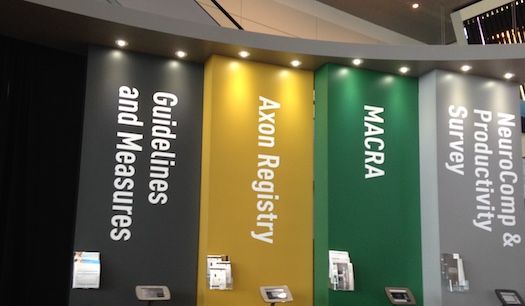Sonja Potrebic, MD, Speaks on Importance and Challenges of Guideline Development
“When we make recommendations, we don’t just use the evidence from the studies.â€

“We’re no longer in an era where doctors says something and patients just do it,” Sonja Potrebic, MD, PhD, said, highlighting the abundance of information and the need for good, consolidated medical recommendations. Potrebic is Vice-Chair of Guideline Development, Dissemination, and Implementation Subcommittee at the American Academy of Neurology, and she eschewed a microphone to speak to a small group at the AAN’s Annual Meeting in Boston. She detailed the difficulties in assembling a series of meaningful recommendations for various medical conditions, but also the importance of the process.
The benefits of a guideline, according to Potrebic, are numerous. They can reduce the number of decisions made by and for patients that may not necessarily beneficial, and they do provide a comprehensive review and (ideally) neutral, even-handed evaluation of best treatment courses.
The challenges, however, are also numerous: the imperative and nuance required in achieving adequate patient input, the mercurial issue of nonfinancial conflicts of interest, and the always-lingering questions about how much a guideline can actually change treatment of a disease, and how quickly.
“You need to involve patients in various different manners,” said Potrebic, “If you live with something, or your family lives with something, you develop a sort of formed expertise…knowing how to decide what you do and don’t want to do.” Patients have a very different perspective on their disease and treatment than clinicians do, often with varying priorities. In anticoagulant use, for instance, she says a clinician is typically more concerned about hemorrhage, whereas the patient is focused on preventing stroke. More generally, clinicians often think in terms of when is best to initiate a form of treatment, while patients are focused on how soon they can cease it.
“When we make recommendations these days, we don’t just use the evidence from the studies,” she says, emphasizing the importance of patient review, clinical experience and context, as well as common sense. She believes it best to engage patients throughout the entire process of guideline development, allowing them to interact with the development and point out when some of the evidence from the systemic review if something seems vastly different from their disease experience.
“In order for patients to understand what we do, we have actually changed how we write some things…when we ask our questions, we ask them in two different ways,” she said, noting that they’ll often pose questions and release drafts with lay language translation to better facilitate such input.
A second, extremely nuanced problem of guideline development is conflicts of interest, but not merely the simple, quantifiable financial type. If a clinician has long held a certain position on a course of treatment, or spoken about it at length, or even works for an organization that has frequently made strong judgments about such course of treatment, it may be very difficult for them to evenly evaluate the evidence.
“These are subtle things, but the strength of a recommendation is a subtle thing, going from ‘should’ to ‘must’,” Potrebic said. The importance is to think from the perspective of a person reading the guideline: although everyone involved in the making of it may believe that every opinion in the room is unbiased, perception is key.
Her final major point of conversation was the difficulty of tracking the impact of a set of guidelines. A treatment proven to be ineffective, she says, can take about a decade to finally fade from medical use, and new treatments that really do work may take longer to implement.
Dtabases, such as those controlled by Medicare, are a way of tracking treatment prevalence and outcomes. Medicare, however, is looking for disease improvement, which Potrebic pointed out often doesn’t exist in clear cut terms for neurologic disorders. That fact “really propelled the AAN to create the Axon registry…where neurologists can report their data, so it’s one less hassle to report to Medicare.”
The Axon registry, which was approved by the Centers for Medicare & Medicaid Services (CMS) in 2016 as a qualified clinical data registry, allows clinicians to directly input their patient data to the AAN. Still, though, without universal terms for symptoms and measurable metrics, the data becomes difficult to interpret.
“It’s going to take a lot of time to develop a mindset where clinicians think in terms, from the start, of what we can measure,” Potrebic acknowledged, while still hopeful for Axon’s potential: “The best implementation will be through the registry.”
The AAN frequently releases guidelines, commenting already this year on “Use of fMRI in the Presurgical Evaluation of Patients with Epilepsy”; “High Quality Reference Values for Nerve Conduction Studies”; and the one announced earlier in this year’s Meeting, “Practice Guideline Summary: Sudden Unexpected Death in Epilepsy Incidence Rates and Risk Factors.”